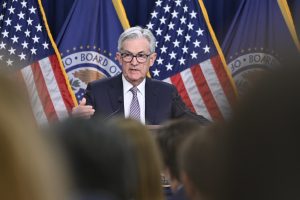The worries over the Coronavirus continue to mount, hurting global markets and sending investors to safer havens, such as government bonds and gold.
The Dow Jones fell 2.8%, more than 800 points, quickly after U.S. markets opened the morning of Feb. 24, erasing all its gains for the year. The S&P 500 fell 2.7%, with all its 11 sectors reporting declines. The Nasdaq Composite also declined, falling 3.2%.
The morning’s steep declines were accompanied by a rush towards haven assets. Investors rushed heavily into gold, sending the price to a new seven-year high.
Prices of the previous metal increased 1.7% to $1,677 a troy ounce. The yield on the 10-year treasury note also fell to near record lows.
It reached 1.365% the morning of Feb. 24, compared to 1.470% on Feb. 21. This is compared to the treasury note’s all-time intraday low of 1.325% and record closing low of 1.366%.
Yields fall when bond prices rise. With fears that the coronavirus could turn into a global pandemic and countries such as Italy and South Korea reporting an increase in deaths, investors rushed to the safety of government debt.
The drop in treasury yields has significantly raised the chance that the Federal Reserve will cut interest rates this year. Investors believe “there is a 74% chance that the Fed cuts interest rates at least twice this year,” according to CME Group data. Only a week ago, investors saw that chance at 46%.
Markets also saw the yield on the 10-year treasury yield drop below that of the three-month bill, creating an inverted yield curve.
An inverted yield curve is a situation in which long-term rates are lower than short-term rates — suggesting that markets have a cloudy perception on the long-term view of the economy and an economic contraction is likely.
The trend extended to European government bonds as well, where the yield on the 10-year German bund fell to -0.498% on Feb. 24 from the -0.440% on Feb. 21. U.K. gilts also dropped to a notable 0.503% from 0.559% in the same time period.
On the other hand, Italian and Greek government bonds saw a notable increase in government bond yields.
Italy saw a rapid increase in both confirmed coronavirus cases and deaths from the virus. Greece’s proximity to Italy led to investors fearing a further spread of the virus.
Both countries have high debt burdens and investors worry the coronavirus has raised the risk of recessions in both countries.
The Italian 10-year bond climbed to above 1% Feb. 24 after ending Feb. 21 at 0.9%, and the Greek 10-year bonds also rose to above 1% from 0.966% in the same time frame.
Data from China about coronavirus has been questioned on its accuracy, raising uncertainty as well. U.S. economic data has begun to show signs of strain from the virus, with U.S. business activity falling to its lowest level in more than six years, oil prices dropping and tech giant Apple Inc. announcing it will not meet revenue expectations due to the virus.
Global markets are unravelling as the coronavirus outbreak disrupts supply chains and continues to spread at unprecedented levels.












